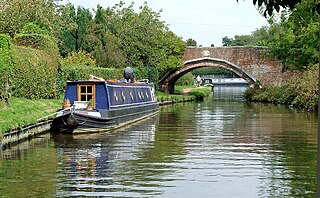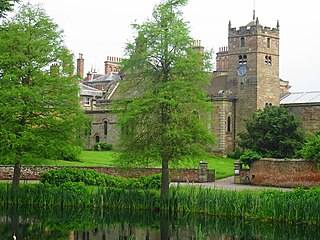
South Staffordshire is a local government district in Staffordshire, England. Its council is based in Codsall. Other notable settlements include Brewood, Cheslyn Hay, Coven, Essington, Featherstone, Four Ashes, Great Wyrley, Huntington, Kinver, Landywood, Penkridge, Perton, Wedges Mills, Weston-under-Lizard and Wombourne. The district covers a largely rural area lying immediately to the west and north-west of the West Midlands conurbation.

Cannock Chase is a local government district in Staffordshire, England. It is named after and covers a large part of Cannock Chase, a designated National Landscape. The council is based in the town of Cannock. The district also contains the towns of Hednesford and Rugeley, as well as a number of villages and surrounding rural areas.

Whittington is a village and civil parish which lies approximately 3 miles south east of Lichfield, in the Lichfield district of Staffordshire, England. According to the 2001 census it had a population of 2,591, increasing to 2,603 at the 2011 Census. The parish council is a joint one with Fisherwick. The Coventry Canal borders the village to the north and east.

Weston Park is a country house in Weston-under-Lizard, Staffordshire, England, set in more than 1,000 acres (400 ha) of park landscaped by Capability Brown. The park is located 10 miles (16 km) north-west of Wolverhampton, and 8 miles (13 km) east of Telford, close to the border with Shropshire. The 17th-century Hall is a Grade I listed building and several other features of the estate, such as the Orangery and the Stable block, are separately listed as Grade II.

Harrietsham is a rural and industrial village and civil parish in the Maidstone District of Kent, England. According to the United Kingdom Census 2001, it had a population of 1,504, increasing to 2,113 at the 2011 Census. The parish is in the North Downs, 7 miles (10 km) east of Maidstone; it includes the settlements of Marley, Pollhill and Fairbourne.

Weston-under-Lizard is a village and former civil parish, now in the parish of Blymhill and Weston-under-Lizard, in the South Staffordshire district of Staffordshire, England. It is known as Weston-under-Lizard to distinguish it from Weston-on-Trent. It should not be confused with the village of Weston, to the north east of Stafford. In 1961 the parish had a population of 294. On 1 April 1986 the parish was abolished and merged with Blymhill to form "Blymhill and Weston-under-Lizard".

Armitage with Handsacre or just Armitage is a civil parish in the Lichfield district of Staffordshire, England. It includes the villages of Armitage and Handsacre, and in 2001 had a population of 5,181, rising to 5,335 at the 2011 Census.

Cadeby is a village and civil parish in the City of Doncaster in South Yorkshire, England. The population at the census of 2011 was 203. It is about five miles west of Doncaster, and four miles east of Mexborough.
Cannock was a rural district in Staffordshire, England, from 1894 to 1974.

Brereton is a village and former civil parish, now in the parish of Brereton and Ravenhill, in the Cannock Chase district, in the county of Staffordshire, England.

Brineton is a hamlet in the South Staffordshire district of Staffordshire, England. It is 1 mile north of the village of Blymhill, and is within the civil parish of Blymhill and Weston-under-Lizard. Its name is derived from the Anglo Saxon term for "Bryni's settlement". The hamlet contains the 17th-century Brineton House, and Laurel Farm, a brick house built in 1678.

Great Chatwell is a small village within the civil parish of Blymhill and Weston-under-Lizard, in the South Staffordshire district of Staffordshire, England. It lies on the border with Shropshire, around 1 mile (1.6 km) north-west of Blymhill.

St. Mary's Church, Blymhill is an Anglican church in the village of Blymhill, Staffordshire, England. The building, which is a Grade I listed building, was constructed in the 14th century and restored and extended in the 18th and 19th centuries. It features an Early English south aisle, a Decorated Gothic chancel and a Perpendicular Gothic tower.

Blymhill is a village and former civil parish, now in the parish of Blymhill and Weston-under-Lizard, in the South Staffordshire district, in the county of Staffordshire, England. It has a church called St Mary's Church. In 1961 the parish had a population of 459. On 1 April 1986 the parish was abolished and merged with Weston-under-Lizard to form "Blymhill and Weston-under-Lizard".

Curborough and Elmhurst is a civil parish in Lichfield District, Staffordshire, England. The hamlets of Curborough and Elmhurst, that make up the parish, lie just north of the City of Lichfield, and are separated from each other by the West Coast Main Line. The parish council is a joint one with Farewell and Chorley. Curborough's name derives from Old English. The words for mill stream in Old English were 'cweorn burna,' and likely referred to Curborough brook.

Brockhurst is a hamlet in Staffordshire, England, 1 mile sorth-west of Blymhill. It is part of Blymhill and Weston-under-Lizard civil parish within South Staffordshire district.

Lapley, Stretton and Wheaton Aston is a civil parish in the South Staffordshire district, in the county of Staffordshire, England. The population of the civil parish at the 2011 census was 2,548.

Patshull is a former civil parish, now in the parish of Pattingham and Patshull, in the South Staffordshire district, in the county of Staffordshire, England. It is 7 miles west of Wolverhampton and 7½ miles east of Bridgnorth. According to the 2011 census it had a population of 212. The parish consisted of Patshull, Burnhill Green and, along its eastern boundary, Westbeech. It formerly contained several farmhouses and small cottages, but Burnhill Green is the main hamlet.
Blymhill and Weston-under-Lizard is a civil parish in the district of South Staffordshire, Staffordshire, England. It contains 61 listed buildings that are recorded in the National Heritage List for England. Of these, five are listed at Grade I, the highest of the three grades, and the others are at Grade II, the lowest grade. The parish contains the villages of Blymhill, Weston-under-Lizard, Brineton, Great Chatwell, and Orslow, and the surrounding countryside. Much of the parish is occupied by the country house Weston Hall and its estate, Weston Park. The house and many structures within the estate are listed. Most of the other listed buildings are houses, cottages, farmhouses and farm buildings, the earlier of which are timber framed or have timber famed cores. The other listed buildings include churches, memorials in the churchyards, and a public house

The Church of St Andrew, Weston-under-Lizard, Staffordshire is a Grade I listed Anglican church. Its origins are medieval, but it was largely rebuilt in the very early 18th century by Elizabeth Wilbraham of Weston Park, and restored in the 19th century, firstly by George Edmund Street and then by Ewan Christian. It remains a functioning parish church in the Diocese of Lichfield.



















